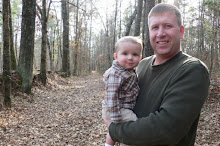Late yesterday I tried to lay the first strip of Redwood down on the forms. I didn't have long enough staples to keep the strips in place, especially at the bow and stern. Last night I bought longer staples (9/16") so I could start this morning to give it another shot. If you remember from the last post, I had to splice two 10' strips together to make a strip long enough to span the kayak. I thought I could glue the splice together while laying the strips down on the forms. My attempt at this technique caused me and the splice a lot of stress!

I decided that I should glue and clamp the splice, then let it dry for sever hours, before attempting to lay it on the forms. This worked out much better, in fact I was able to get the first and second strip laid down on both side before calling it quites for the night.


The ends on the bow & stern are coming together good too. After the strips are down and the glue is dry, I will need to grind and sand the ends down to a nice smooth bevel..
Project Elapsed Time : 26.0 Hrs











